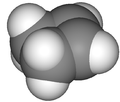| |||
| Names | |||
|---|---|---|---|
| Preferred IUPAC name Cyclobutene | |||
| Identifiers | |||
3D model (JSmol) | |||
| ChEBI | |||
| ChemSpider | |||
| ECHA InfoCard | 100.011.360 | ||
| EC Number |
| ||
PubChem CID | |||
CompTox Dashboard (EPA) | |||
| |||
| |||
| Properties | |||
| C4H6 | |||
| Molar mass | 54.092 g·mol−1 | ||
| Appearance | Colorless gas | ||
| Density | 0.733 g/cm3 | ||
| Boiling point | 2 °C (36 °F; 275 K) [1] | ||
Except where otherwise noted, data are given for materials in their standard state (at 25 °C [77 °F], 100 kPa). | |||
Cyclobutene is an organic compound with the chemical formula C4H6. It is a cycloalkene. It is a colorless gas that easily condenses. It is of interest in research but currently has no practical applications. A modern synthesis involves the 2-step dehydration of cyclobutanol. [1] The compound was first prepared by thermolysis of the ammonium salt [C4H7N(CH3)3]OH (cyclobutyltrimethylammonium hydroxide). [2]
Cyclobutene thermally isomerizes to 1,3-butadiene. This strongly exothermic reaction reflects the dominance of ring strain. In contrast, the corresponding equilibrium for hexafluorocyclobutene disfavors hexafluorobutadiene. [3]

